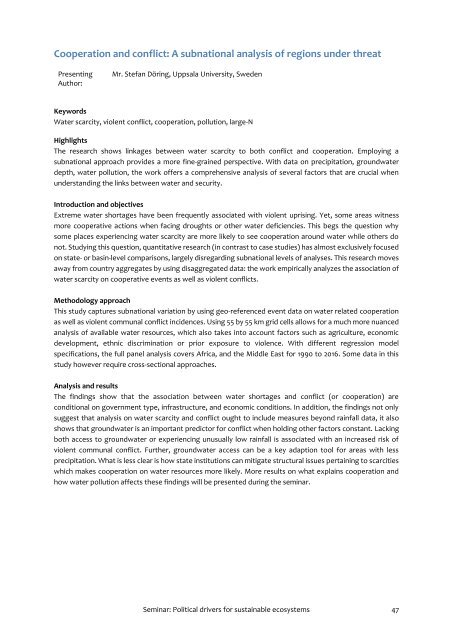2018 Abstract Volume
A compilation of the oral and written scientific presentations chosen to be part of World Water Week 2018 Seminars.
A compilation of the oral and written scientific presentations chosen to be part of World Water Week 2018 Seminars.
You also want an ePaper? Increase the reach of your titles
YUMPU automatically turns print PDFs into web optimized ePapers that Google loves.
Cooperation and conflict: A subnational analysis of regions under threat<br />
Presenting<br />
Author:<br />
Mr. Stefan Döring, Uppsala University, Sweden<br />
Keywords<br />
Water scarcity, violent conflict, cooperation, pollution, large-N<br />
Highlights<br />
The research shows linkages between water scarcity to both conflict and cooperation. Employing a<br />
subnational approach provides a more fine-grained perspective. With data on precipitation, groundwater<br />
depth, water pollution, the work offers a comprehensive analysis of several factors that are crucial when<br />
understanding the links between water and security.<br />
Introduction and objectives<br />
Extreme water shortages have been frequently associated with violent uprising. Yet, some areas witness<br />
more cooperative actions when facing droughts or other water deficiencies. This begs the question why<br />
some places experiencing water scarcity are more likely to see cooperation around water while others do<br />
not. Studying this question, quantitative research (in contrast to case studies) has almost exclusively focused<br />
on state- or basin-level comparisons, largely disregarding subnational levels of analyses. This research moves<br />
away from country aggregates by using disaggregated data: the work empirically analyzes the association of<br />
water scarcity on cooperative events as well as violent conflicts.<br />
Methodology approach<br />
This study captures subnational variation by using geo-referenced event data on water related cooperation<br />
as well as violent communal conflict incidences. Using 55 by 55 km grid cells allows for a much more nuanced<br />
analysis of available water resources, which also takes into account factors such as agriculture, economic<br />
development, ethnic discrimination or prior exposure to violence. With different regression model<br />
specifications, the full panel analysis covers Africa, and the Middle East for 1990 to 2016. Some data in this<br />
study however require cross-sectional approaches.<br />
Analysis and results<br />
The findings show that the association between water shortages and conflict (or cooperation) are<br />
conditional on government type, infrastructure, and economic conditions. In addition, the findings not only<br />
suggest that analysis on water scarcity and conflict ought to include measures beyond rainfall data, it also<br />
shows that groundwater is an important predictor for conflict when holding other factors constant. Lacking<br />
both access to groundwater or experiencing unusually low rainfall is associated with an increased risk of<br />
violent communal conflict. Further, groundwater access can be a key adaption tool for areas with less<br />
precipitation. What is less clear is how state institutions can mitigate structural issues pertaining to scarcities<br />
which makes cooperation on water resources more likely. More results on what explains cooperation and<br />
how water pollution affects these findings will be presented during the seminar.<br />
Seminar: Political drivers for sustainable ecosystems 47


















